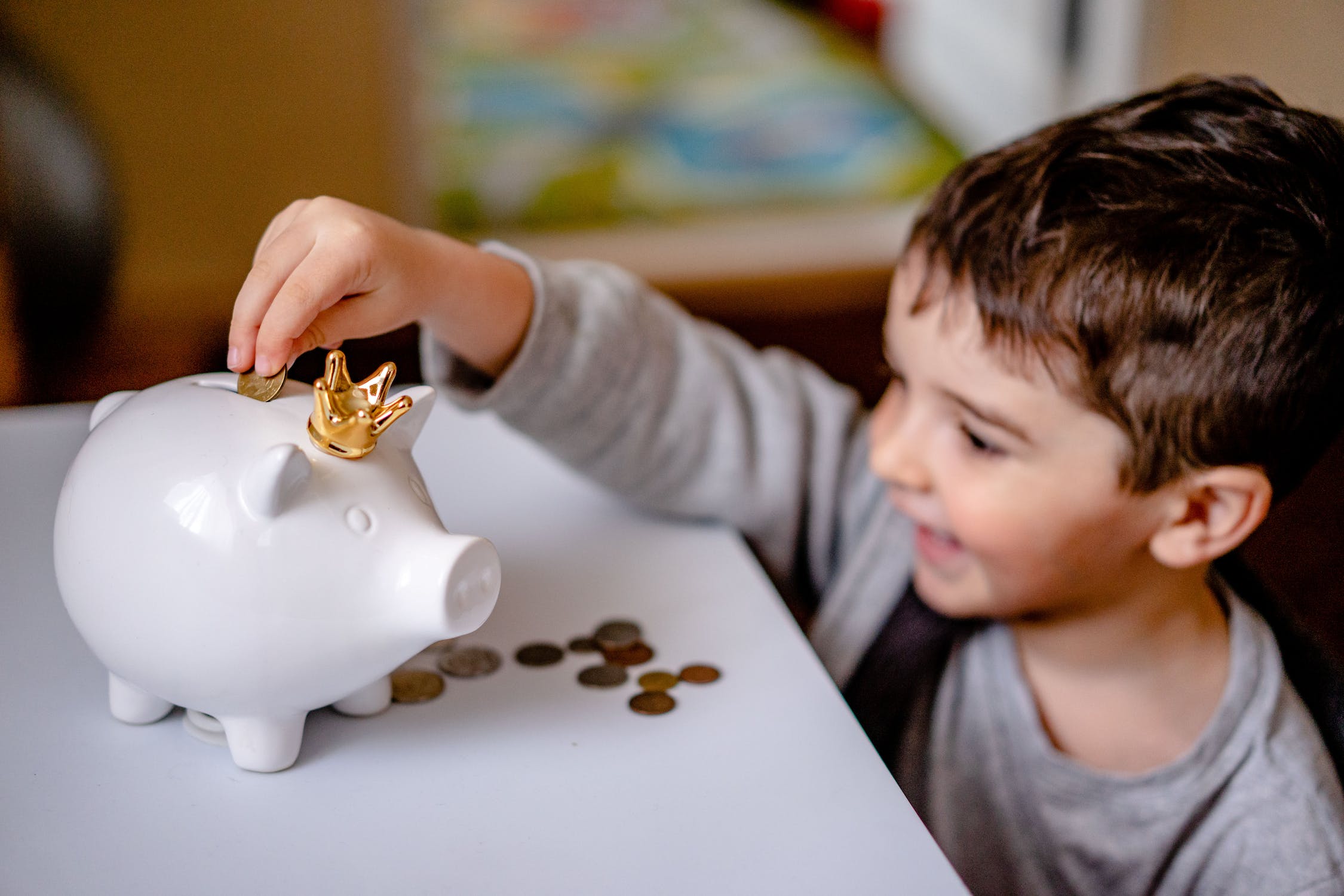Financial education for kids is essential start at an early age is crucial for helping them develop good money management habits and a solid understanding of financial principles.
1. Start Early
Starting financial education at a young age means introducing children to basic money concepts and financial literacy as soon as they are old enough to comprehend.
This strategy aims to make learning about money a natural and ongoing part of their upbringing.
According to the ChooseFI Foundation, 1 in 5 teens lacks basic financial literacy, highlighting the gap in their preparedness to manage their finances and make informed financial decisions, which can have long-term consequences for their financial well-being.
Here are some suggestions to help you encourage kids to start early:
Introduce the Basic Concepts
Simple ideas like what money is, what it’s used for, and how it’s earned can be taught to children. You may, for instance, explain that money is something that individuals use to purchase goods and that it is obtained via labor.
Everyday Learning Opportunities
When children receive their allowance or go shopping with their parents, these are the ideal times to teach them about money. The price of items, the idea of change while making purchases, and how money is exchanged for goods and services are all things you can discuss.
Gradual Learning
Adapt the child’s financial education to their age, starting with simpler ideas and moving on to more complicated ones as they get older. For instance, small kids can learn to recognize different coins and bills, while older kids can understand ideas like budgeting and saving.
Starting early creates a solid financial foundation, normalizes family financial conversations, and encourages kids to develop solid financial habits and responsibilities as they get older.

2. Use Real Money
Using real money refers to using real, tangible items like coins and bills to teach kids about money and financial concepts.
The practical aspects of money, such as its various denominations and its use in transactions, are made more accessible to kids using this technique.
Here are some examples of how you can use real money to teach children about money:
Identify Different Denominations
Encourage your child to recognize various currency denominations, like pennies, nickels, dimes, quarters, and dollar bills, through organizing and counting activities.
Counting and Math Skills
Use real money for enjoyable learning experiences, like counting and practicing basic math skills through exercises involving adding or subtracting money amounts with your child.
Role-Playing Games
Engage in role-playing games with children, allowing them to take on the roles of buyers and sellers and using real money to simulate transactions, purchases, and making change, fostering their understanding of real-life money usage.
Grocery Shopping
Include your child in grocery shopping, where they can assist in selecting items, checking prices, and making payments at the checkout counter, providing a real-world understanding of the cost of living.
Comparing Prices
While shopping, demonstrate to children the importance of comparing prices and making informed choices, instilling in them the value of securing the best deal for their money.
By using actual money, kids can develop a more realistic grasp of how money functions in real life, which will improve their financial literacy and skills as they get older.
3. Teach Budgeting
Teaching budgeting to children involves introducing them to the concept of planning and allocating money for various purposes, like saving and spending, that are suitable for their age and understanding.
According to The Motley Fool, a budget is followed by more than 40% of youngsters, which may pave the way for a more secure adult life. This can help children better understand the value of money and how to manage it effectively.
Here’s how you can explain and teach budgeting to kids:
Define Budgeting
Begin by defining a budget as a financial plan, similar to a map guiding you to a destination, and highlighting its role in ensuring enough money for both needs and wants.
Allocate Allowance
Use your child’s allowance to teach budgeting by having them split it into categories like saving for specific goals, spending on desired items, and sharing with charity or others.
Saving
Motivate your child to set savings goals, whether for toys, outings, or long-term goals like college, and regularly allocate a portion of their allowance toward these goals.
Spending
Let your child decide on purchases within their budget, helping them discern if it’s a necessity or a want, fostering informed spending.
Sharing
Foster generosity by discussing charity and involving your child in deciding where to donate, instilling empathy and social responsibility.
Track and Adjust
Help your child track money in and out to raise spending awareness and adjust their budget when needed, even with a simple approach like using paper.
Teaching budgeting early helps kids develop lifelong money management skills, emphasizing the importance of planning, saving, decision-making, and financial responsibility.

4. Savings Account
Encourage kids to develop a savings habit by teaching them how savings accounts work, which banks and credit unions offer that allow money to grow over time through deposits and earned interest.
According to a University of Kansas study, young adults who began savings accounts as children are more likely to keep them open and invest in stocks, which can help secure their future financial security.
Here’s how you can explain and teach savings accounts to kids:
Introduction to Savings Account
Begin by defining a savings account as a secure place to keep money, like a bank’s piggy bank, and stress that money stored there can grow through a concept called “interest.”
Opening an Account
Consider opening a child’s savings account at a local bank or credit union, involving them in the process, as many offer accounts with lower minimum balance requirements.
Depositing Money
Motivate your child to regularly deposit money into their savings account, whether from their allowance, gifts, or earnings from chores or a part-time job if they’re older.
Interest
Simplify the concept of interest for your child by telling them the bank adds a little extra money (interest) to their savings account over time as a reward for saving, showing how their money can grow.
Setting Savings Goals
Assist your child in setting savings goals, such as toys, trips, or college, to motivate their savings and foster a sense of accomplishment upon achievement.
Monitoring Progress
Regularly review the savings account statement with your child, showing how their balance grows from savings and earned interest, providing visual motivation for continued saving.
By introducing children to savings accounts and involving them in the process, you’re instilling valuable financial habits and helping them understand the benefits of saving for the future.
5. Understanding Credit and Debt
Credit is a fundamental concept in the financial world. At its core, credit gives individuals the power to purchase something now and pay for it later.
For kids, it’s like getting an advance on their allowance with the promise to pay it back. However, borrowing isn’t free.
Often, there’s an added cost called “interest,” a percentage of the borrowed amount.
Kids need to understand that while credit can be beneficial, it comes with the responsibility to repay what’s borrowed, plus any interest.
The Concept of Loans
Loans are a specific type of credit where money is borrowed for a particular purpose. For instance, people might take out a loan to buy a house, a car, or pay for college. Like any other form of credit, loans must be paid back, often in monthly installments.
Kids must grasp that they’re committing when someone takes out a loan. They promise to repay the borrowed amount, plus any interest, over a set period.
Defaulting on a loan or not paying it back can have severe consequences, affecting one’s ability to borrow in the future.
Credit Cards
Credit cards are a common tool that adults use to make purchases. Instead of paying with cash or a check, they can use a credit card to buy something now and pay for it later.
For kids, think of it as a magic card that lets you get things even if you don’t have the money immediately. But this “magic” comes with strings attached.
Every month, the credit card company sends a bill for what was spent, and if it’s not paid in full, interest gets added.
It’s vital to emphasize to kids the importance of using credit cards wisely. Spending more than one can afford and not paying off the balance can lead to accumulating debt, which can spiral out of control.
Good Debt vs. Bad Debt
Not all debts are created equal. Some debts can be seen as an investment in one’s future, while others can be detrimental to financial health.
Good debt, for example, might include student loans. When someone borrows money to pay for education, they invest in their future, hoping their degree will lead to a higher-paying job.
On the other hand, bad debt might include excessive credit card debt from unnecessary purchases. Such debt doesn’t enhance one’s prospects and can lead to financial strain.
Kids need to discern between the two, recognizing that while borrowing can be a tool for growth, it should be approached with caution and understanding.
6. The Importance of Investing
Teaching kids about investing is a crucial extension of financial education. Just as we teach them to save, educating them on how to grow their savings is equally vital.
Investing is not just about making more money; it’s about understanding the value of money, the potential of patience, and the balance between risk and reward.
Basics of Investing
Investing, in its simplest form, is putting money into ventures, assets, or endeavors to generate a profit or financial gain in the future. It’s like planting a seed and waiting for it to grow.
For kids, this can be related to letting their money “work” for them rather than just storing it away. By investing, they’re giving their money a job: to grow and multiply.
Types of Investments
One can invest in numerous ways, and it’s essential to introduce kids to the basic types to give them a foundational understanding.
- Stocks: This is a share in the ownership of a company. When you buy stock, you own a piece of that company and can benefit from its growth.
- Bonds: These are like loans that investors give to organizations, usually the government or corporations. In return, they receive periodic interest payments and get their loaned amount back after a certain period.
- Real Estate: This involves buying property, like houses or land, with the expectation that its value will increase over time.
For kids, you can liken these to different ways they might use their allowance. Stocks are like buying a piece of a toy company and getting more toys as the company makes more.
Bonds are like lending a toy to a friend and getting an extra toy every month until they return it. Real estate is like buying a toy box and hoping more kids will want to store their toys in it for a fee.
Risk and Reward
Every investment comes with its own set of risks and potential rewards. Kids must understand that there’s no guaranteed success in investing.
However, they can increase their chances of positive outcomes with proper knowledge and informed decisions.
Relate this to a game of soccer: there’s no guarantee they’ll win every match, but with practice, strategy, and understanding of the game, they can increase their chances of scoring goals.
Compound Interest
One of the most powerful concepts in investing is compound interest. It’s the idea that the interest earned on an investment doesn’t just add up; it multiplies.
For instance, if kids save $10 and earn 10% interest annually, they’ll have $11 at the end of the first year. But in the second year, they earn interest not just on the initial $10 but also on the $1 interest from the first year, making it $12.10, and so on. It’s like a snowball effect where their money grows faster and bigger over time.
A simple way to explain this to kids is by using the analogy of a tree: the money they invest is like the seed, the interest is the branches, and compound interest means each branch grows its own smaller branches, making the tree bigger and denser over time.

Entrepreneurship and Earning Money
Entrepreneurship is more than just a buzzword; it’s a mindset and a way of life. At its core, entrepreneurship is creating and running a business.
For kids, understanding entrepreneurship can be a gateway to financial independence and a means to make their ideas come to life. As we teach children about saving and budgeting, introducing them to entrepreneurship can be a pivotal step in their financial education journey.
Ways Kids Can Earn Money
When it comes to entrepreneurship, the sky’s the limit, even for kids! There are numerous age-appropriate entrepreneurial ventures that children can embark on.
Classic examples include setting up a lemonade stand or offering lawn mowing services in the neighborhood.
With the digital age upon us, online ventures such as starting a blog, creating craft items to sell on platforms like Etsy, or even offering online tutoring for subjects they excel in, can be great options.
These ventures provide kids with a source of income and valuable skills like marketing, customer service, and product development.
Value of Hard Work
One of entrepreneurship’s most invaluable lessons is the value of hard work. It’s not just about making money; it’s about the dedication, perseverance, and effort to earn it.
Kids engaging in entrepreneurial activities quickly learn that success doesn’t come overnight. It requires planning, effort, and a lot of dedication.
This hands-on experience instills a strong work ethic in children, making them appreciate the satisfaction and pride of earning their own money.
Learning from Failures
In the world of business, not every venture is a guaranteed success. There will be times when ideas don’t pan out or when unexpected challenges arise.
However, these setbacks are not the end; they are learning opportunities. Kids must understand that failures are a natural part of the entrepreneurial journey.
Instead of being disheartened, they should be encouraged to analyze what went wrong, learn from their mistakes, and use those lessons to improve and innovate.
Embracing failures as growth opportunities fosters resilience and adaptability, traits that are invaluable in both business and life.
Managing Money: Financial Education for Kids at an Early Age
By teaching money skills early, you’re helping them build a strong foundation for a financially secure future.
In summary, teaching kids about money early helps them develop lifelong financial skills and responsible money management habits, ensuring a more secure financial future.
Keep in mind that learning about finances is a continuous process. Adjust your strategy based on your child’s age, maturity level, and specific needs.

No responses yet